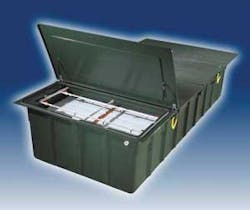Effluent Sewer Technology Saves Excavation Cost on Rehab Project
By Bob Smith
Older sewers are often plagued with inflow and infiltration (I&I), increasing flow and potentially overloading pump stations and treatment plants. Because of the difficulty of finding and correcting sources of I&I -- especially sources on private property -- and because of the high cost of replacing or repairing gravity sewers, communities often deal with this problem by simply accepting increased I&I and upsizing the treatment plant to accommodate the extra water.
A simpler solution is to replace the gravity collection system with an effluent sewer system. Effluent sewers use small diameter (2-in.) pipe that can be “sleeved through” larger, failing gravity pipes using trenchless technology. For a Rhode Island developer, this particular benefit eliminated an unpredictable excavation cost and made a 2008 sewer rehab feasible.
Wickford Village Apartments is a privately owned affordable-housing development in North Kingstown, RI. Converted in 1976 from military housing, the development consists of 70 one-bedroom units, 27 two-bedroom units, and 32 three-bedroom units, plus a community center and the Town’s police and fire station. Originally, the development was served by a gravity sewer with a large pump station that fed central septic tanks, with effluent going to a leach field.
null
The sewer, constructed of asbestos-cement pipe, was plagued by infiltration and effluent was surfacing in the neglected leach field.
As part of an overall renovation of the development, a new treatment system was proposed. Under the initial concept the gravity sewer lines would go to a single large septic tank, and an AdvanTex Treatment System, manufactured by Orenco Systems, would provide secondary treatment. The AdvanTex system is a packed-bed filter in which effluent is recirculated through a bed of synthetic textile.
Treatment to 10/10 mg/L BOD/TSS takes place in an array of compact pods. In the Wickford Village system, the treated effluent is discharged from the pods to a bottomless sand filter.
“The facility gravity sewer was a huge concern because of the potential I&I impact on the treatment system,” said Bob Johnson of Atlantic Solutions Ltd., Portsmouth, RI, which supplied the Orenco equipment for the project.
The project’s construction manager, Stand Corp., Warwick, RI, realized that the treatment system they were asked to construct didn’t make sense.
“We questioned the need for such a large tank that required significant excavation within a tidal groundwater that was not going to fit in our client’s budget. Atlantic Solutions also had a concern that the treatment system might not work to its full potential with I&I from the old gravity system. For these reasons, we knew we had to challenge the original design,” said Ron Caniglia of Stand.
Stand then asked Pare Corp., Lincoln, RI, to provide the engineering services, and together they looked for ways to reduce the project’s cost.
To eliminate the significant cost of the excavation for the large treatment tank, and avoid potential problems with infiltration into the old sewer lines, Armando Ricci of Pare decided to design a STEP system with septic tanks at each of the 18 buildings and effluent pressure sewer lines inserted through the existing 2,600 linear feet of gravity pipelines. These 18 tanks, rather than the single large tank, would provide the required storage volume, and the pressure pipelines would eliminate the I&I problem.
In a STEP system, sewage is collected in a two-compartment processing tank at each building. Solids and scum remain in the tank for years, decomposing and reducing in volume. Effluent is filtered and pumped through small-diameter collection lines to a central secondary treatment system. The on-site collection and distribution system is virtually immune to I&I.
To minimize disruption of services to residents, the project was completed in stages. First, the contractor, Ricci Drain-Laying, Inc., Providence, RI, installed the AdvanTex Treatment System and drainfield. Atlantic Solutions assisted with installation of the treatment system and provided testing and start-up services.
Next, Ricci Drain-Laying installed 18 STEP tanks, each serving a building with several apartments. Once complete, 2 inch polyethylene effluent collection lines were systematically pulled through the old gravity sewer lines and connected to each tank.
With a design flow of 36,850 gpd, the new system was completed in the fall of 2008, meeting the original project budget cost.
“Use of Orenco’s STEP system technology afforded the owner cost savings for this project, by avoiding excessive excavation, limiting cutting and patching of streets and sidewalks, and minimizing disruption for residents of the neighborhood,” Ricci said.
Atlantic Solutions will continue to provide operation and maintenance services for the system.WW
About the Author:
Bob Smith is a regional leader in the Engineered Systems group at Orenco Systems in Sutherlin, OR.


